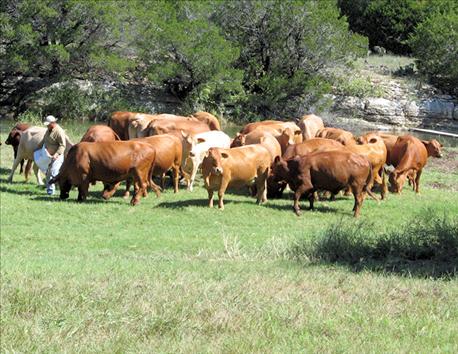February 29, 2016

Genetics are the foundation of a beef cattle operation and need to be managed from a written program. In designing a breeding program, the producer should first decide what type of animal is desired and then select the most efficient and economical breeding system to accomplish the goal. These decisions should be influenced by production environment, herd size, marketing program and management style.
 CROSSBRED: This calf is the result of a cross between a Brahman and Herford, an F1 cross.
CROSSBRED: This calf is the result of a cross between a Brahman and Herford, an F1 cross.
“Cattle breeding systems are either purebred (straightbreeding) or crossbred (cross-breeding) categories,” says Dr. Andy Herring, Texas A&M AgriLife Research. “In straightbreeding, the same breed of sire and dam are used continually, so progeny usually are rather uniform in appearance. Purebred operations must rely primarily on additive genetic effects, achieved through selection of parents.”
Crossbreeding advantages
“Crossbreeding begins with the mating of two pure breeds. The term, F1, is usually applied to progeny of such a cross,” continues Herring. “An advantage of crossbreeding is hybrid vigor, commonly referred to as heterosis. It is measured as performance of crossbred progeny compared to the average performance of purebred parents.
Related: 5 traits you want in a beef breeding heifer
 MULTIPLE LINES: Beefmaster cattle are a composite breed of Brahman, Milking Shorthorn, and Hereford.
MULTIPLE LINES: Beefmaster cattle are a composite breed of Brahman, Milking Shorthorn, and Hereford.
“Generally, there is more hybrid vigor when the breeds being crossed are more genetically different such as crossing animals from different biological groups rather than breeds within the same group (Table 1). It is possible to achieve some hybrid vigor when different families within the same breed are crossed, but this will always be less than when two breeds are crossed. A large percentage of cow-calf producers in the United States utilize some type of crossbred cows in their herds to take advantage of hybrid vigor for cow fertility, longevity and calf survival.”
 There are two types of heterosis – individual and maternal. Individual heterosis is the increase in production seen in the crossbred offspring. This type of heterosis is generally expressed in growth traits.
There are two types of heterosis – individual and maternal. Individual heterosis is the increase in production seen in the crossbred offspring. This type of heterosis is generally expressed in growth traits.
“Maternal heterosis is the increase in average production observed in crossbred females compared to straightbred females,” says Dr. Jane Parish, Mississippi State University. “Maternal heterosis is often noted in increased calving percentages, higher weaning weights, greater longevity in the dams, and other reproductive traits. Enhanced production from the crossbred female is the primary benefit from a planned crossbreeding system. Therefore, it makes sense to cross a straightbred bull on crossbred females to take advantage of maternal heterosis.

Crossbreeding also provides the ability to combine traits from two or more breeds into one animal. This is called breed complementarity, which occurs when crossbred animals exhibit desirable characteristics from each parent’s breed resulting in a more valuable animal.
Crossbreeding systems
“Cross breeding systems may utilize terminal, rotation or rotaterminal crosses (see figure below). The two-breed terminal system is the most basic crossbreeding system available,” Parish explains. “In this system, females of one breed are mated with bulls of a different breed producing F1 offspring. All of the offspring from this initial cross are marketed, and replacement heifers are purchased.
Related: What's in a beef bull breeding exam and fertility test?
 “The three-breed terminal system requires breeding F1 heifers to a purebred bull. Because replacement heifers are purchased, a source of quality crossbred females is essential. To maintain uniformity in progeny, purchased replacements should be similar to females in the breeding herd.”
“The three-breed terminal system requires breeding F1 heifers to a purebred bull. Because replacement heifers are purchased, a source of quality crossbred females is essential. To maintain uniformity in progeny, purchased replacements should be similar to females in the breeding herd.”
“Two-breed rotation or crisscross breeding systems involve a specific cyclical pattern of mating breeds of bulls to progeny resulting from a preceding cross,” says Dr. Bill Lamberson, University of Missouri. “In a Hereford-Angus rotation, progeny resulting from an initial Hereford-Angus cross would be backcrossed to one of the parental breeds, perhaps Angus. The resulting backcross progeny, 3/4 Angus and 1/4 Hereford, are mated to Hereford bulls and this cyclical pattern continues.
“After three generations, breed composition stabilizes at approximately 2/3 the breed of the sire and 1/3 the other breed. In this example, generation four calves are sired by an Angus bull and are approximately 2/3 Angus and 1/3 Hereford.”
“Three-breed rotations simply add a third breed of bull to the mating cycle used in a two-breed rotation,” explains Lamberson. “Cows are mated to the breed of bull that makes up the smallest proportion of their composition.”
“A three-breed rotaterminal system is an extension of the two-breed rotational system” says Parish. “A percentage of the breeding females are placed in the two-breed rotation, and another percentage is mated to a terminal sire. For example, 50 percent of herd females are in the two-breed rotation, and 50 percent are mated to a terminal sire. The females in the two-breed rotation produce replacement heifers, and the females in the terminal cross produce all market calves.”
Before selecting a breeding system, study the advantages and disadvantages of each option to ensure that your choice will be the best for your operation and production goals.
You May Also Like




